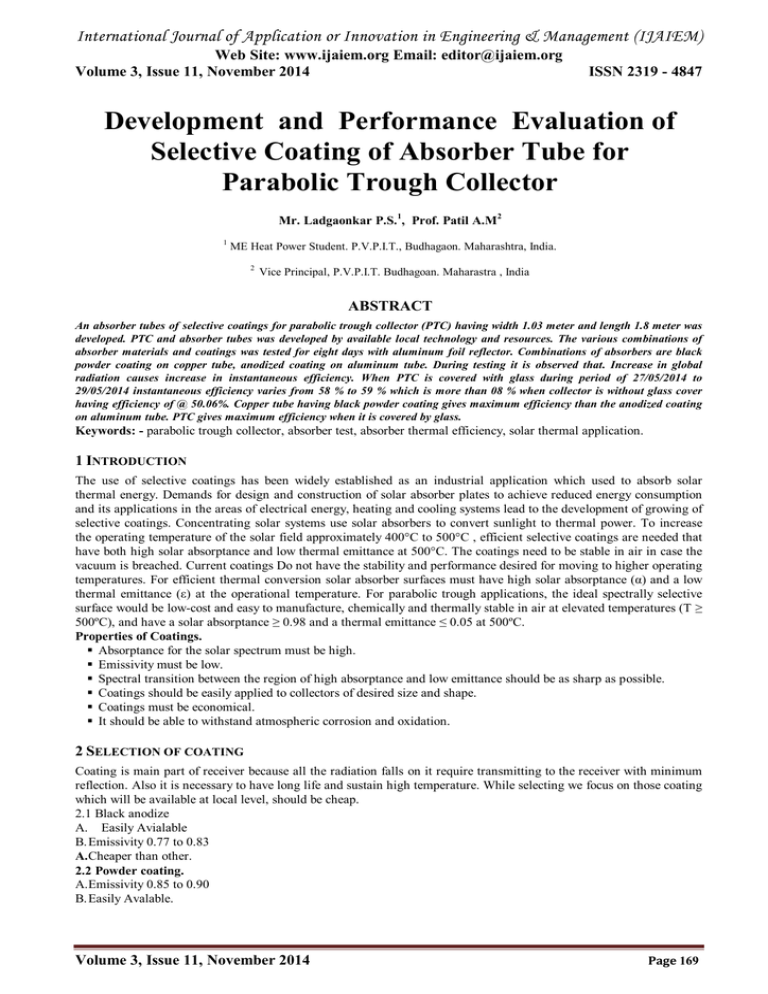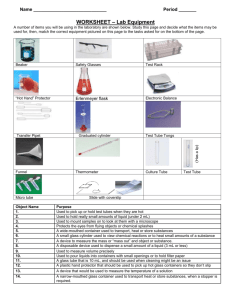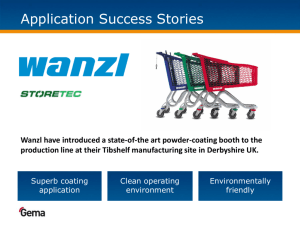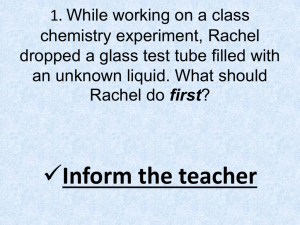Document 13269438
advertisement

International Journal of Application or Innovation in Engineering & Management (IJAIEM) Web Site: www.ijaiem.org Email: editor@ijaiem.org Volume 3, Issue 11, November 2014 ISSN 2319 - 4847 Development and Performance Evaluation of Selective Coating of Absorber Tube for Parabolic Trough Collector Mr. Ladgaonkar P.S.1, Prof. Patil A.M2 1 ME Heat Power Student. P.V.P.I.T., Budhagaon. Maharashtra, India. 2 Vice Principal, P.V.P.I.T. Budhagoan. Maharastra , India ABSTRACT An absorber tubes of selective coatings for parabolic trough collector (PTC) having width 1.03 meter and length 1.8 meter was developed. PTC and absorber tubes was developed by available local technology and resources. The various combinations of absorber materials and coatings was tested for eight days with aluminum foil reflector. Combinations of absorbers are black powder coating on copper tube, anodized coating on aluminum tube. During testing it is observed that. Increase in global radiation causes increase in instantaneous efficiency. When PTC is covered with glass during period of 27/05/2014 to 29/05/2014 instantaneous efficiency varies from 58 % to 59 % which is more than 08 % when collector is without glass cover having efficiency of @ 50.06%. Copper tube having black powder coating gives maximum efficiency than the anodized coating on aluminum tube. PTC gives maximum efficiency when it is covered by glass. Keywords: - parabolic trough collector, absorber test, absorber thermal efficiency, solar thermal application. 1 INTRODUCTION The use of selective coatings has been widely established as an industrial application which used to absorb solar thermal energy. Demands for design and construction of solar absorber plates to achieve reduced energy consumption and its applications in the areas of electrical energy, heating and cooling systems lead to the development of growing of selective coatings. Concentrating solar systems use solar absorbers to convert sunlight to thermal power. To increase the operating temperature of the solar field approximately 400°C to 500°C , efficient selective coatings are needed that have both high solar absorptance and low thermal emittance at 500°C. The coatings need to be stable in air in case the vacuum is breached. Current coatings Do not have the stability and performance desired for moving to higher operating temperatures. For efficient thermal conversion solar absorber surfaces must have high solar absorptance (α) and a low thermal emittance (ε) at the operational temperature. For parabolic trough applications, the ideal spectrally selective surface would be low-cost and easy to manufacture, chemically and thermally stable in air at elevated temperatures (T ≥ 500ºC), and have a solar absorptance ≥ 0.98 and a thermal emittance ≤ 0.05 at 500ºC. Properties of Coatings. Absorptance for the solar spectrum must be high. Emissivity must be low. Spectral transition between the region of high absorptance and low emittance should be as sharp as possible. Coatings should be easily applied to collectors of desired size and shape. Coatings must be economical. It should be able to withstand atmospheric corrosion and oxidation. 2 SELECTION OF COATING Coating is main part of receiver because all the radiation falls on it require transmitting to the receiver with minimum reflection. Also it is necessary to have long life and sustain high temperature. While selecting we focus on those coating which will be available at local level, should be cheap. 2.1 Black anodize A. Easily Avialable B. Emissivity 0.77 to 0.83 A. Cheaper than other. 2.2 Powder coating. A. Emissivity 0.85 to 0.90 B. Easily Avalable. Volume 3, Issue 11, November 2014 Page 169 International Journal of Application or Innovation in Engineering & Management (IJAIEM) Web Site: www.ijaiem.org Email: editor@ijaiem.org Volume 3, Issue 11, November 2014 ISSN 2319 - 4847 3 DEVELOPMENT OF ABSORBER TUBE, AND SYSTEM SPECIFICATION There are number of material available for the receiver. Tube material select on the basis of thermal conductivity and cost , two materials for receiver are used Copper and another is Aluminum. 3.1Properties of Copper: It has very high thermal conductivity. It has high melting point (approx. 1360 °C) It has Good Corrosion resistance. It is easily machinable. 3.2Properties of Aluminum: It has good thermal conductivity. It has good thermal stability. It has high melting point approx. Corrosion resistance and low density. 3.3Combination of coating and absorber tube. There was two absorber tubes and two coatings taken and these coatings apply by electrodepositing method and powder coating method on the tube. Table No 1 Combination of coating and absorber tube Sr No Absorber tube. Coating Applying Method. 1 Aluminum Black anodize Electroplating 2 Copper Black powder coating. Powder Coating. 3.4System specification: Table No2 System specification Prototype dimensions used for testing Sr. No Particular Symbol Value 1 Width W 1.03m 2 Length L 1.8m 3 Depth D 0.3m 4 Tube Diameter d 0.019m 5 Concentration Ratio C 17 6 Focal Point f 0.221 7 Reflector Aluminum Foil ρ 0.85 8 Mass flow rate m Minimum 60 lit/day 4 EXPERIMENTAL TEST SETUP In Diagram also shows the instruments which are used for experimentation Volume 3, Issue 11, November 2014 Page 170 International Journal of Application or Innovation in Engineering & Management (IJAIEM) Web Site: www.ijaiem.org Email: editor@ijaiem.org Volume 3, Issue 11, November 2014 ISSN 2319 - 4847 Figure No 1 Experimental Test Setup 4.1 Test procedure Thermal performance of parabolic trough collector can be evaluated by obtaining value of instantaneous efficiency. Efficiency can obtained by measuring values of Incident beam radiation, inlet water temperature, outlet water temperature, wind speed etc under steady state or quasi static state. Test procedure consists of following steps:1. Proper orientation of PTC. 2. Checking water level in Cold water storage tank. 3. Choosing proper combination of reflector and absorber tube. 4. Adjusting flow rate of water as per requirement. 5. Connection of k type thermocouple at proper location and checking temperature indicator. 6. Use of lux meter and anemometer for obtaining values of solar radiation and wind speed respectively. 7. Proper tracking of trough after fixed interval of time to obtain highest beam radiation. 8. Taking the readings at regular interval. 9. Same procedure is repeated by next day by changing the flow rate and absorber tube. By using above procedure we perform experiment from 25th May 2014 To 1st June 2014. During the testing we change the parameters which are briefly tabulated below. Testing was taken from 10 A.M. to 4 P.M. 4.2 Various combinations of receiver and reflector for data collection: For the evaluation each of receiver (absorber) tube and coating, make different combinations for different days. For evaluation reflector used as a aluminum foil which have good reflectivity. Different receiver tube like copper and aluminum with coating of black powder coating and black anodize used. Combination is tested in two conditions with complete glass cover on the parabolic trough collector and without glass cover on the parabolic trough collector. 4.3 Combinations for test: R = Aluminum foil A = Anodize on Aluminum tube. C = Black powder coating on copper tube. Table No 3 Combination of testing Sr. No. Date Combi-nation Mass flow rate (kg/s) Case 1 25/05/2014 RxC 0.0021 With-out Volume 3, Issue 11, November 2014 glass Page 171 International Journal of Application or Innovation in Engineering & Management (IJAIEM) Web Site: www.ijaiem.org Email: editor@ijaiem.org Volume 3, Issue 11, November 2014 2 26/05/2014 RxA 0.0021 3 27/05/2014 RxC 0.0023 4 28/05/2014 RxC 0.0030 5 29/05/2014 RxC 0.0041 6 30/05/2014 RxA 0.0023 7 31/05/2014 RxA 0.0030 8 01/06/2014 RxA 0.0041 ISSN 2319 - 4847 cover on PTC With glass cover on PTC 5 RESULTS 1 Efficiency of system , when system without glass cover (0.0021 kg/s mass flow rate) Table No 04 Efficiency of system Sytem without glass cover Sr No. Black Powder coating Anodize coating 01 50.06 % 46.51 % Graph No 01 Time of the day vs instantaneous efficiency 2 Efficiency of system when system with glass cover having black powder coating. Table No 05 Efficiency of system when system with glass cover having black powder coating Sr No. Mass Flow Rate Efficiency 01 02 0.0023 kg/s 0.0030 kg/s 59.01 % 58.85 % 03 0.0041 kg/s 59.00 % Graph No 02 Efficiency of system when system with glass cover having black powder coating Volume 3, Issue 11, November 2014 Page 172 International Journal of Application or Innovation in Engineering & Management (IJAIEM) Web Site: www.ijaiem.org Email: editor@ijaiem.org Volume 3, Issue 11, November 2014 ISSN 2319 - 4847 Table No 06 Efficiency of system when system with glass cover having anodize coating. Sr No. Mass Flow Rate Efficiency 01 0.0023 kg/s 52.49 % 02 0.0030 kg/s 03 0.0041 kg/s 52.67 % 52.69 % Graph No 3 Efficiency of system when system with glass cover having anodize coating 6 SELECTION OF SYSTEM 6.1 when system without glass cover. From table number 03, and graph no 01 shows that Black powder coating on copper tube having more efficiency than the anodized coating on aluminum tube. Hence system having black powder coating on copper tube is selected when it is without glass cover 6.2 Selection of system when system with glass cover. Table No 06 Efficiency of system when system with glass cover Sr No. Average efficiency of black powder coating Average efficiency of Anodize coating 58.95 52.62 01 From table 6, when system with glass cover, heat losses due to air is minimized and efficiency of the system increases. Efficiency of black powder coated copper tube going from 52.62% to 60.30%. Efficiency of anodized tube increases up to 50.39%. From above table, system having black powder coating on copper tube is selected because of more efficiency than the anodized coating. 7 CONCLUSION [1] When PTC without glass cover (25/05/2014) and black powder coated tube was used, we get average instantaneous efficiency over a day 51.06 %. [2] When PTC without glass cover (26/05/2014) and anodized coated tube was used, we get average instantaneous efficiency over the day 46.51 %. [3] When PTC covered with glass during period of 27/05/2014 to 29/05/2014 and black powder coated tube was used, we get instantaneous efficiency which is varies from 58.7 % to 59.3 %. [4] When PTC is covered with glass cover during period of 30/05/2014 to 01/06/2014 and anodized coated tube was used, we get instantaneous efficiency which varies from 52.49 % to 52.69 % [5] In the case of black powder coated copper tube. There is rise in instantaneous efficiency at least by 08 % due to top glass cover. [6] In the case of anodized coating. There is rise in instantaneous efficiency at least by 6 % due to top glass cover. [7] Due to glass cover conductive and convective type heat loss decreases. Volume 3, Issue 11, November 2014 Page 173 International Journal of Application or Innovation in Engineering & Management (IJAIEM) Web Site: www.ijaiem.org Email: editor@ijaiem.org Volume 3, Issue 11, November 2014 ISSN 2319 - 4847 [8] Overall efficiency of PTC for period of two days when system without glass cover was about 48.79 %. [9] Overall efficiency of PTC for period of six days when system with glass cover is about 55.78 %. [10] Higher efficiency was achieved by black powder coated absorber tube 8 FUTURE SCOPE. Manufacturing of evacuated tube with locally available materials and testing for solar thermal applications. Study of effect of variation of mass flow rate on thermal performance of absorber tube. Study of variation of inlet water temperature, pressure on outlet condition. Developing new coating for absorber and it performance evaluation Suggestion for use of PTC for small scale domestic and industrial solar thermal application. Developing solar tracker for solar application. Study of performance of absorber tube by changing reflecting material. Study of performance of PTC by changing tube diameter. Study of performance of PTC by changing concentration ratio. REFERENCES [1] Kalogirou Soteris A., “Solar thermal collectors and applications”, Progress in Energy and Combustion Science 30, 2004, pp 231–295. [2] Kennedy C., Price H., “Development and Testing of High-Temperature Solar Selective Coatings”, National Renewable Energy Laboratory, Colorado, NREL/CP-520-36581, [3] January 2005.Paulescu M. et al, “Solar Radiation Measurements”, Green Energy and Technology, DOI: 10.1007/978-1-4471-4649-0_2 London 2013, pp 17-43. [4] Kennedy C., Price H., “Development and Testing of High-Temperature Solar Selective Coatings”, National Renewable Energy Laboratory, Colorado, NREL/CP-520-36581, January 2005. [5] S. S. Patil, N.N. Shinde, “Performance Evaluation of Absorber and Modified Parabolic Trough Collector system for Solar Thermal Applicatins Using Black Copper on Copper tube”,Recent Practices In Conventional & Non Conventional Energy Resources, 8th & 9th February 2013, pp42-46 [6] www.esrl.noaa.gov [7] www.ies.co.jp/math/java/conics/focus/focus.html. [8] S.P Sukhatme-Solar energy. Tata McGraw-Hill Publishing company,1984. Volume 3, Issue 11, November 2014 Page 174






